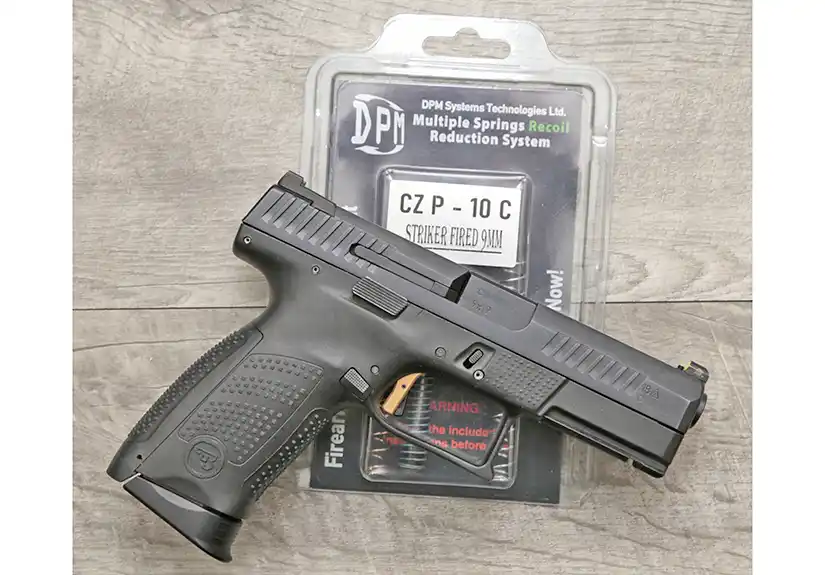DPM Systems offers its Mechanical Recoil Reduction System for a variety of firearms. While they sell a broad range of products for different firearms, I chose to focus on the CZ P10 series pistols first. These lightweight polymer pistols are affordable, reliable, and have decent triggers, right out of the box. They also seem to have pretty good recoil mitigation. But being so light, there is certainly some room for improvement. When I contacted DPM to see about a review, they sent me a few units for testing and evaluation in the P10 S, C, and F models. This turned out to be very useful, as the results for each pistol were similar, yet varied.
First, a bit about DPM Systems
Since 2003, DPM Systems Technologies LTD has been developing products that improve the operation of portable defensive weaponry. In simpler terms, they have designed products that make handheld firearms easier to shoot effectively, and reduce wear and tear. Military and law enforcement around the world carry firearms with their patented products. Testers fired tens of thousands of rounds through individual pistols equipped with their products without failure.
DPM Sytems lists the advantages of their system as better double-tap concentration, along with faster follow-up shots. Both are a direct result of the recoil reduction, which improves speed between shots. One point that I cannot test, but have no reason to doubt, is the elimination of jams. You can reduce a cause of jams with a smoother recoil system that’s tunable via springs. But as most CZ owners will attest, jams are very infrequent. I have yet to experience one with the trio of CZ P10 pistols I bought for testing purposes.
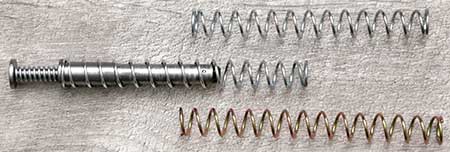
DPM Mechanical Recoil Reduction System
This system replaces the OEM recoil rod without changing the configuration of the pistol. It works via a multi-spring intricate rod and controls the functionality of the gun. Contained within the rod is a spring that controls the movement of the slide, slowing it at the end of its travel. This prevents the battering on the frame that might otherwise occur over the life of the firearm.
Consider the typical 9mm pistol that may see rounds from 115 to 147 grains, with varying charges, up to +P. If you don’t balance spring weight with bullet weight/powder charge, you will increase both recoil and wear. DPM includes two additional springs, enabling fine-tuning to specific ammo. This is the system used in the CZ P10 C and F models.

DPM Telescopic Mechanical Recoil Reduction System
This is the system used in the CZ P10 S. It’s very similar to the one above, although it has three springs instead of two. The use of multiple springs is dictated by the limited space of subcompact pistols such as the CZ P10 S. The system aligns all three springs within the single unit and gradually compresses them under cycling. Like all DPM recoil reduction systems, it controls the motion of the slide, preventing harsh impacts to the frame of the pistol. The result is a reduction in felt recoil and longer firearm life. You can tune to match your preferred ammo, as the manufacturer includes multiple external springs.
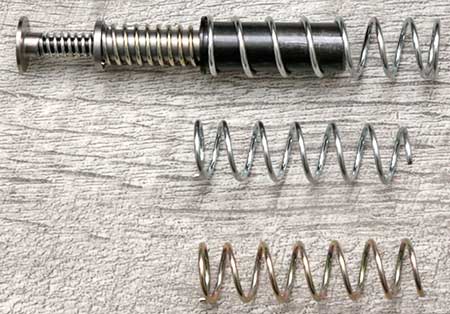
Installation of the DPM Mechanical Recoil Reduction System
In theory, installing one of these devices in a pistol should be as easy as swapping a standard recoil assembly. However, the extra length of the external springs used for tuning makes it slightly more challenging. Not difficult, just not quite a drop-in. More like “Drop in with patience”. It’s important to make sure that the external spring is seated and aligned correctly. Other than that, it was a quick job to swap them out on the tailgate of a truck during our testing at the range.
Testing methodology, AKA, range time
On my first range trip with the CZ P10 S, I thought it was a bit snappy. Even after the swap, I wasn’t sure how to evaluate its effectiveness. Despite it shooting quite well, quantifying the results wasn’t going to be easy.
And then I realized that the Mantis X system would provide actual feedback, rather than anecdotal evidence. So I loaded ten rounds and shot five while recording the results using the Mantis system. Then I swapped the rod for the DPM, topped the magazine off at ten again, and shot five more rounds. I wanted the additional weight of the extra rounds, but also checked the results to make sure the diminishing weight wasn’t affecting accuracy. This process was repeated with each pistol.
CZ pistols generally eat any ammo and aren’t fussy at all. So all my testing was done with 115 grain ammo from a couple of different manufacturers because that’s what I had on hand. Heavier rounds may have a different recoil impulse, but I feel like the 115 is “snappiest” in the light pistols. We had three guns, two recoil systems for each, and multiple shooters. Tracking all the data for multiple bullet weights would have been a lot more involved, yet I am not sure it would have added much value.
First up, the CZ P10 S
Coming from the metal-framed 75 series, the P10 S is smaller, lighter, and clearly has a bit more “snap”. I can still shoot it well, and reasonably fast. Yet there is no denying that muzzle rise. The Mantis records muzzle movement as the trigger is pulled, making the score more reliable than merely hitting our steel target. It measures how far off from the point of aim the pistol is as it’s fired. It also shows the total time for the five-round strings. In theory, the DPM System should provide quicker follow-up shots, and higher accuracy over a string of shots. Each five-shot string was shot as quickly as recoil would allow, while still hitting the target.
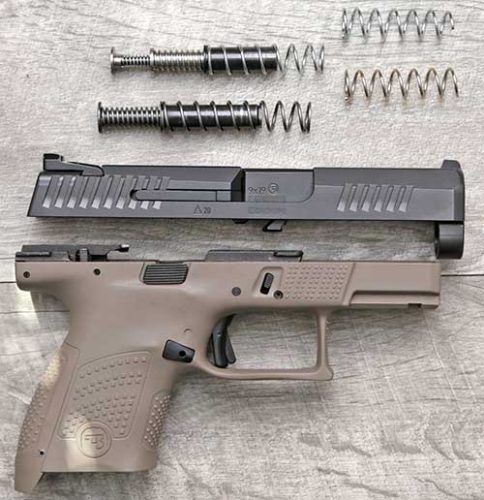
The average score for the CZ P10 S with the OEM recoil rod was in the mid 70s. This was achieved at an average speed of 6.44 seconds. After swapping in the DPM Telescopic Mechanical Recoil Reduction System, things got interesting. Felt recoil didn’t seem perceptibly different, but the scores and times told another story. The average score went up about ten points while the average time dropped by about a second. That translates to tighter groups in less time. More on that in a bit.
Next up, the CZ P10 C
With its upgraded trigger from CZ Custom and a little more weight plus a longer sight radius, I had higher expectations for the CZ P10 C. Initial scores were in the low 80s, with the five-shot group taking roughly 4.5 seconds, on average. After swapping the DPM unit in, average scores approached 90, and time was cut by about half a second. This was pretty consistent over several tests.
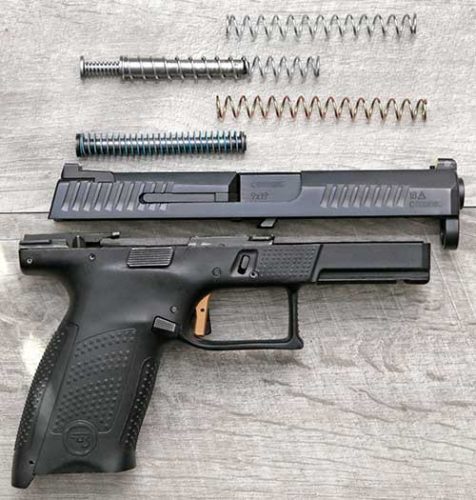
Hitting an 8-inch target at seven yards is easy enough, even when trying to shoot fairly quickly. What the data shows is that I was spending less time getting back on target. Looking at the bigger picture, it’s obvious that I should be able to shoot faster and more accurately with a compact pistol, compared to a subcompact pistol. And then the differences between the factory recoil assembly and the DPM would be smaller, but still apparent. At this point, I was very curious to see how the largest of the three would do.
Chonky full size, the CZ P10 F
I’ve got the least amount of rounds through the CZ P10 F, and it’s also the newest of the three. Plus it’s got an optic. More weight, yet sight radius removed as a factor contributing to accuracy. None of that should matter much, as we’re testing the recoil system, but it’s still worth noting.
What shouldn’t surprise anyone is that the accuracy for the CZ P10 F was night and day better than the other two. It was consistently in the 90s, yet my time was also slower, approaching the 6-second mark. Some of that may be due to the overall newness of this pistol. After swapping in the DPM, I saw some 95 and 98 scores, with only a small drop in overall time.
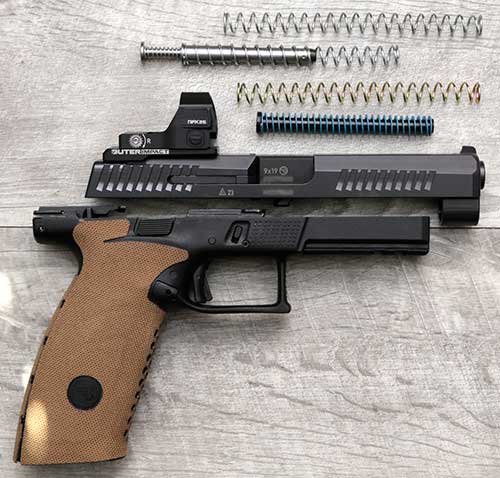
What did I learn from the data?
I’ve got a couple of takeaways here. There’s no magic here, only physics. The DPM Systems Mechanical Recoil Reduction System can only do so much. It will tame a smaller pistol a bit, improving overall shootability. But it’s not going to make a subcompact shoot like a full-size pistol. And it will improve everyone’s favorite carry size, the compact pistol. Compact pistols hit the sweet spot for size and accuracy, and the difference is noticeable. By the time we got to the full size, I anticipated seeing less obvious results, and I was mostly right. It can only do so much for really bad (subcompacts), or really good (full-size) pistols.
Does that mean the DPM System is not worth considering for anything other than compact pistols? No, quite the opposite, actually. Those little pistols are getting beat up with every round fired. Smoothing out that recoil impulse isn’t just about improving accuracy and follow-up shots. It contributes to the longevity of the pistol. On the opposite end, full-size pistols are a great choice for competition. Who wouldn’t want an edge in accuracy over multiple round strings, with shorter split times? And with competition comes high round counts. Why not take advantage of the longer life of your competition pistol? In other words, the DPM System can offer benefits for all three pistol sizes.
Who can benefit from this system?
I consider myself a high-volume shooter, burning up thousands and thousands of rounds each year. But the majority of that is rimfire and the rest is across multiple firearms. If I was shooting thousands of rounds through a single firearm, the DPM Systems Mechanical Recoil Reduction System will not only help my speed and accuracy but also reduce some wear and tear. So that would make a lot of sense. A police officer that I shoot with regularly has the system in his personal EDC, which says something as well. Whether for competition or defense, it’s a reliable and proven system, with quantifiable results.
Conclusion
Retail pricing for the systems generally vary from under $80 to over $100. This all depends on the pistol, as well as the turning options. The more expensive kits include extra options for tuning. For a competitive or defensive edge, that’s inexpensive. If this interests you, check out the DPM Systems website for the full line of products.
As always, I’d like to thank DPM Systems for providing their products for this review. I really enjoy seeing these kinds of advancements in firearms technology, and getting to know the people behind it. If you found this article informative, stay tuned as I’ve got another one planned used identical metal-framed CZ 75 pistols, one with the system installed, the other without.
Feel free to ask any questions or share your comments below.
